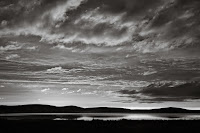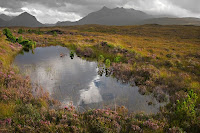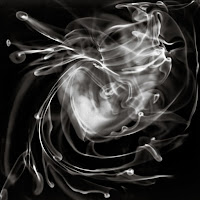
The NY Times recently published a fascinating article on the subject
"how people engage art" in art galleries. As one might expect, there are a variety of "approaches" people take to viewing art. Some walk around slowly, savoring each artistic morsel on a wall. Some walk through the gallery quickly, hardly glancing at much of anything save for the watch on their wrist (in hopes of escaping, perhaps). Some bring their sketchbooks, look around a bit, then find a spot to rest for a while and try to "take away" a bit of what they've seen (or are looking at). Some come in groups, that congeal and disperse in rhythms, punctuated by periodic outbursts of comments and discussion, as they weave their way through the displays.
The article reminded me of my own experiences of watching "people passing through a gallery" while I was still a member of the Lorton Arts
Workhouse Photographic Society (WPS). Part of my Co-op duties included gallery-sitting, for which I had to come in to open the gallery, greet guests, photography admirers and/or potential customers, answer questions, conduct sales, and so on. In truth, apart from the motivation to "do more photography" while I was part of the Co-op, my most enjoyable experience was in greeting and schmoozing with passerbys and interested observers. As I write this blog entry, two months or so removed from my last such sitting, I must admit to missing the opportunity to experience this on a regular basis.

For context, the WPS gallery (Gallery W-6 at Lorton Arts), contains about 120-130 prints at any one time, (new hangings occur at roughly 8 to 9 week intervals) and the main gallery is about 100 feet by 20 feet in size (there is a smaller space for pictures at the front entrance, that contains an additional 15 or so prints). Here are some of my miscellaneous observations about how "people wander through the gallery," culled from nine months worth of informal record keeping:
(1) People are generally quiet - very quiet, as though they are in a library - as they walk through the gallery. In many cases, even if I attempt to initiate a conversation in a regular tone of voice, the response is muted, hardly above a whisper.
(2) The average "walk through" time (of people who choose
not to interact with me after my greeting them; this class makes up only about a quarter of the people who enter the gallery) is about 3 minutes, plus/minus a minute or so. It's pretty fast. A short look is all that most prints get, even as the people are moving on to the next picture. Another interesting statistic: about half the people entering the gallery choose to look at only about half of the pictures; they leave before completing a full circuit around the gallery! (Personally - speaking as both photographer and gallery viewer - I also tend to move quickly through a gallery, giving
most pictures about 10 secs worth of attention. However, I have rarely been to any gallery, of any kind, in which at least a few images/paintings did not grab my attention and hold it for long stretches. Indeed, it is the anticipation and possibility of encountering such "grab your eye/I/mind/soul" art that brings me to galleries in the first place.)
Note: thoughtful readers who may be musing about the role that "thin-slicing" (=
rapid cognition) may play in art viewing will find interesting reading in Malcom Gladwell's
Blink.
(3) About half the people who enter the gallery are happy to reciprocate in an exchange of pleasantries and otherwise ask questions about the art and engage my presence in the gallery. Indeed, for
this class of gallery observer, the interaction with me only seems to spur their own interest in the art, for they spend, on average, at least two to three times the length of time simply "viewing the art" than does class one (as defined above). (Of course, this may simply be a correlation between the type of person who is both more interesting in photography and, simultaneously, more predisposed to engaging others in some verbal exchange.)
(4) A small minority (about 5-10%) appear interested only in the fact that there is a human being in the gallery with whom they can speak about photography, rather than the photographs themselves. This class of observer enters the gallery, looks around not for the prints on the wall, but for the gallery-sitter, makes a bee-line toward that person, and is the one to initiate contact. Also, about half the time, the ensuing conversation is more about
their art, rather than the prints they have yet to see in the gallery they've just entered.

(5) 10-15% of the people passing through are also photographers. Sometimes they are identified by the cameras strapped to their neck; sometimes it is revealed through conversation. However, in
almost all such cases, the affect is one of humility on their part. And often, from my point of view, in a quite unjustified manner, for many turn out to be accomplished photographers. Strangely, this fact is more often than not revealed only after some gentle coaxing (by the gallery sitter/gallery-photographer); most (even those that are obviously carrying a camera!) are reluctant to reveal their talents. My impression is that by virtue of being inside of a gallery alone, and by being in the presence of a "photographer" whose works are on the wall, somehow their own abilities, skills and accomplishments are lessened or outright unimportant. It is truly a strange phenomenon, but perhaps not all that surprising, psychologically. Objectively speaking, there is no deeper meaning to, say, having
my pictures hanging on the wall in the room they are in than the objective fact that my pictures happen to be there. It is not, in any way, a statement about or reference to the photographic skill possessed by the humble gallery observer. As I write this entry, I am no longer a member of the WPS, and therefore have no pictures on their gallery walls. I'd certainly like to believe that my photographic skills, such as they are, have not diminished. (Though I secretly wonder, too, whether I'd be a wee-bit more reluctant to "reveal" my photography side were I to enter some new gallery?)
(6) 10-15% of the people wandering through the gallery take their time, seemingly with
every picture. I cannot over-state how this makes the gallery-sitter's heart soar, because - speaking as one - I could palpably feel in their manner a genuine interest in what was displayed on the walls. This class of observer takes a sincere delight in each and every artist, taking the time to read our bios, the titles of the works, and slowly - sometimes with hands clasped behind their backs - relishing the images near and far, craning their necks for a closeup, and stepping back to admire a print from a different perspective. Somewhat surprisingly, only about half of the people in this group overlap with the class that loves to chat.

(7) I just mentioned that the WPS has short "Bios" up on the wall next to each artist's exhibit. However, we did this only many months after opening, and initially had nothing but titles by the individual works, without so much as a marker informing the viewer that "this wall" has photographer X's works, and "that wall" has works by photographer Y. The week after we put up the bios, interest in particular photographers' works (depending on the predilections of the viewer of course) and likelihood of engaging the gallery-sitter sky-rocketed. Intuitively, it makes sense that if a viewer can learn something of interest about a given artist - - and even more so if he or she learns something of interest about an artist who
happens to be the gallery-sitter that day - that the viewer is that much more inclined to react to that artist's body of work and also enagage the photographer/gallery-sitter in conversation. (Before the bios went up, I was amused by how often I'd be asked, incredulously,
"Are all of these works yours?")
(8) Most people are not attracted to, and do not resonate (on any discernible level) with
abstract photography. Please keep in mind that is a strictly personal observation, and in reference to how I observed people "react to my own work" (which is frequently deep into the abtstract dimension). It is not a statement about aesthetics, or what is "good" or "bad" in photography. I state it purely as a matter of "fact" that I've consistently observed over the run of my nine-month membership in the WPS. (FYI: Brooks Jensen, co-editor of
Lenswork magazine, has an
interesting podcast on this subject.) On many more occasions than I am willing to admit (though, implicitly, I'm doing so here;-), particularly when - by chance - my own pictures were hanging near where the gallery-sitting desk and chair are stationed, I would see a prospective buyer approach one of my abstracts, muttering (though loud enough for me to hear): "
Whoa, what in the world...?" (followed by what I
could have mistaken for either a look of horror or disgust or both, as he or she or they quickly made their way to someone else's picture of something more recognizably "real looking").
Note: readers interested in abstract photography are urged to look out for a wonderful new book on the history of abstract photography called
The Edge of Vision (by Lyle Rexer).

(9) A very small minority (maybe a handful of people over the entire nine-month period I'm summarizing) were - ahem - less than gracious and humble. With an obvious chip on their shoulder, they would march toward the gallery-sitter desk, announce their arrival (at least by their manner, the loud clop-clop of their shoes banging the floor, and their wide-open staring eyes, seemingly daring anyone in their path to a fight), and proceed to "explain" to the gallery-sitter (i.e., me) that while some of the photographs here are interesting (though they barely even glanced at any of them), it is really
their art that belongs here instead of the photographers' who were juried into the WPS. On a positive note, once I politely explained that they too can easily become members of the WPS, provided they assemble a portfolio, and submits prints, a vitae and an artists statement - and are selected by the admissions jury - they all turned on their heels and stormed out the gallery.
(10) There is one final class of gallery viewer whose membership totals exactly one person (at least during my time as gallery sitter): the person who is herself an artist and who deliberately seeks out a particular photographer in hopes of engaging in an
aesthetic dialectic. I was introduced to this class during WPS' 08/09-holiday open house and small works show. I saw a woman, about my age, enter the gallery, take a quick look around, and then immediately head for the wall that had my pictures hanging. Naturally curious (as this seldom happens to my pictures), I quietly approached her and introduced myself. She was shy, but smiled, and started asking a few questions about my photos. I started giving my (by now practiced) general overview, but soon realized there was increasing depth to her questions; none were of the basic "So, what is this supposed to be?" variety. She mentioned how some of the images were very Tao-like, and my approach reminded her of some Chinese landscapes (and mentioned a few artists' names I have forgotten). As we talked, it became increasingly irrelevant as to who was "viewing" and who was "the photographer." She eventually confessed that she too was an artist (and teacher) at Lorton, specializing in Chinese art. She explained that she had seen some of my smaller works, that were at that time hanging in the main gallery (
Gallery W-16 at
Lorton Arts), and heard about our open house; she came specifically to meet the photographer behind the pictures she liked so much. Shoot forward a few weeks, after I had a chance to visit my new friend at her own studio (and admire her art), and we were
both rewarded with new art for our walls: she, with an image of mine she so admired at the photography show; I with an exquisite little Zen Frog that adorns my "day job" office and who has himself become an inseparable part of me. A beautiful example of art meeting art, and art sharing of itself to inspire more art.
 Postscript #1:
Postscript #1: My dad, a lifelong artist who lived art 25 hours out of every 24 (incredible, but somehow true!), carved out a niche all his own as a gallery-viewer. His approach was simple, direct, and pure: gallery day was gallery
day, meaning that the entire day would be spent viewing art, in a preternaturally transcendent state that rendered him utterly oblivious to everything around him. My mom and I both saw first hand how my dad would arrive at a gallery -
any gallery - reposition his glasses slightly as he entered (his traditional "I'm now in a gallery" maneuver), clasp both hands behind his back (where they would unmovingly remain throughout the tortuously long day), walk up to the nearest exhibit, and look, and look, and look...and there he would remain -
at that first exhibit! - for hours at a time! Eventually he would move, but only a few feet either to the left or right of whatever he was just viewing, and only to plant himself in front at an adjacent painting. (It was not unheard of for him to suddenly remember something he had forgot to "look for" at the last painting, and - frantically, as though this oversight would somehow deprive him of a morsel of divine truth - side-step his way back to the previous exhibit.) At times, my dad would stand motionless in front of an artwork for so long, that gallery visitors could easily be forgiven for mistaking him for a newly scultpured artwork on display! By the end of a typical day, in a gallery with ten rooms adorned with, say, 300 pieces of artwork, my dad would still be looking (
meditating, absorbing, reflecting, musing, comparing, composing, digesting, pondering, philosophizing, ...) at maybe the 7th or 8th picture in the first room. And at the end of a typical gallery day, as the guards began begging us to leave, my dad would invariably turn to my mom with his own soulful plea:
"Katie, please, please, can we come back tomorrow?" (Never did I see anyone remotely resembling this unique class of "gallery viewer" in all my days of gallery sitting at the WPS.)
Postscript #2: All of the images of "gallery viewers viewing art" are from one of my dad's last exhibits before he died, held at
Adelphi University (Garden City, Long Island, NY) in June 2000. The viewers are looking at some of his amazing
abstracts. The image directly above
Postscript #1 is of my dad at his Adelphi exhibit.
Postscript #3: The artist with whom I exchanged some artwork (and whose "Zen Frog" is my faithful office companion) is
Hsi-Mei Yates, and she specializes in Chinese watercolor brush painting. Her work is exquisite.
 About two years ago, in Dec 2007, I was privileged to have a solo exhibit of 24 of my photos at a book store/gallery in Coral Gables, Fl (you can look up a blog entry I wrote up about it at the time here). Not too long afterwards, I self-published a book woven around the theme of the exhibit - "Natural Order" vs. "Human Generated Order" - called Elements of Order. The book includes all the photos that were exhibited, along with about twice as many additional images that fit into the same theme.
About two years ago, in Dec 2007, I was privileged to have a solo exhibit of 24 of my photos at a book store/gallery in Coral Gables, Fl (you can look up a blog entry I wrote up about it at the time here). Not too long afterwards, I self-published a book woven around the theme of the exhibit - "Natural Order" vs. "Human Generated Order" - called Elements of Order. The book includes all the photos that were exhibited, along with about twice as many additional images that fit into the same theme.



















